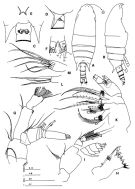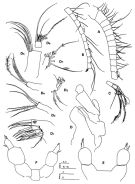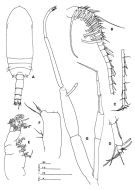|
|
 |
Fiche d'espèce de Copépode |
|
|
Calanoida ( Ordre ) |
|
|
|
Clausocalanoidea ( Superfamille ) |
|
|
|
Aetideidae ( Famille ) |
|
|
|
Parabradyidius ( Genre ) |
|
|
| |
Parabradyidius angelikae Schulz & Markhaseva, 2000 (F,M) | |
| | | | | | | Ref.: | | | Schulz & Markhaseva, 2000 (p.78, figs.F,M); Markhaseva & al., 2008 (p.2433: Rem.); Markhaseva & Schulz, 2008 (p.48, Rem.: Male) |  issued from : K. Schulz & E.L. Markhaseva in Mitt. hamb. zool. Mus. Inst., 2000, 97. [p.79, Fig.1]. Female (from E Weddell Sea): A, habitus (dorsal); B, idem (lateral right side); C, genital segment (ventral); D, idem (lateral right side); E, rostrum; F, caudal rami (ventral); G, A2; H, Md (masticatory blade); I, Md (mandibular palp); K, Mx2 ( (endopodal armature incomplete); L, Mx2 (basal endite); M, Mx2 (terminal part). Nota: Rostrum robust, bifurcate with short diverging points without filaments.
|
 issued from : K. Schulz & E.L. Markhaseva in Mitt. hamb. zool. Mus. Inst., 2000, 97. [p.80, Fig.2]. Female: A, A1 (ancestral segments 1 to XV); B, idem (ancestral segments XVI to XXIV); C, idem ( segments XXV to XXVIII); D, Mx1 (armature omitted); D1, Mx1 (praecoxal arthrite); D2, Mx1 (coxal epipodite); D3, Mx1 (coxal endite); D4, Mx1 (1st basal endite; D5, Mx1 (2nd basal endite; D6, Mx1 (endopod); D7, Mx1 (exopod); E, P5; F, P5 (anterior, variation). Nota: A1 (24-segmented) reaching to posterior end of genital segment. - Mx1: praecoxal arthrite with 9 spiniform, 4 posterior and 1 anterior setae; coxal epipodite with 7 strong and 2 shorter setae; coxal endite with 5 setae; 1st and 2nd basal endites with 4 and 5 setae, respectively; endopodal segments mostly fused and armed with 15 unequal setae; exopod with 11 setae. - P5 uniramous, 3-segmented; coxa fused to intercoxal sclerite; basis globular and unarmed; 3rd segment very small bearing 1 outer proximal and 1 distal spine accompanied by 1 spine-like point incorporated basally to segment. A single paratype (body length 5.70 mm) was different (Fig.2F): 2nd segment (basis) on right side distinctly larger than on left, with small inner hook proximally on right; small remnants of endopodal buds mediodistally on both sides ornamented with setules; 3rd segment (1st exopodal segment) distinctly larger than in holotype and remaining specimens bearing 1 outer and 1 terminal spine; terminal spine accompanied by spine-like point.
|
 issued from : K. Schulz & E.L. Markhaseva in Mitt. hamb. zool. Mus. Inst., 2000, 97. [p.82, Fig.3]. Female: A, Mxp (syncoxa); B, Mxp (fused 1st endopod segment and distal part of endopod); D, P1 (anterior); E, P2 (posterior).
|
 issued from : K. Schulz & E.L. Markhaseva in Mitt. hamb. zool. Mus. Inst., 2000, 97. [p.83, Fig.4]. Female: B, P3 (posterior); C, P4 (posterior). Male: D, habitus (lateral right side); E, Md; F, Mx1. Nota: A1 (24-segmented on left and 23-segmented on right side) extending to 3rd pediger somite; Md with coxa small lacking any gnathobase (masticatory blade).. mx1 reduced, small; praecoxal arthrite with small, curled setae; coxal and basal endites with about 5, 4, and 5 small setae; exopod large with 11 setae; coxal epipodite unarmed.
|
 issued from : K. Schulz & E.L. Markhaseva in Mitt. hamb. zool. Mus. Inst., 2000, 97. [p.79, Fig.1]. Male: A, habitus (dorsal); B, left A1 (ancestral segments 1 to XIX); C, idem (ancestral segments XX to XXVIII); D, idem (distal segments); E, Mx2; F, Mxp (syncoxa); G, P5. Nota:Ratio prosome to urosome length about 2.4 : 1. - Urosome 5-segmented. - Anal somite very short. - A1 24-segmented on left and 23-segmented on right and extending to 3rd pedigerous somite. - Mx2 very small carrrying aesthetasc-like, curled setae. - P5 biramous, simple; right leg shorter (0.7 times) and more slender than left one; right basis extending to middle of left basis; right endopod of simple rod)like appearance, indistinctly 2-segmented and extending to end of 1st exopodal segment; right exopod indistinctly 3-segmented, 1st armed with small outer spine distally, 2nd about as long as ist, 3rd about 2/3 length of 2nd carrying strong spine distally, its length about 1/2 of 2nd and 3rd segment. Coxa of left leg about double width of right one; basis indistinctly 2-segmented, rod-like endopod inserted subdistally; exopod indistinctly 3-segmented; distal (3rd) segment short, mostly fused to curved exopodal segment 2 and armed with inner row of spinules increasing in length distally; straight digitate process tapering to blunt tip and furnished with set of small spinules directed medially.
| | | | | Ref. compl.: | | | Bradford-Grieve, 2004 (p.284) | | | | NZ: | 1 | | |
|
Carte de distribution de Parabradyidius angelikae par zones géographiques
|
| | | | | | | Loc: | | | Antarct. (E Weddell Sea: off Vestkapp) | | | | N: | 1 | | | | Lg.: | | | (809) F: 5,75-5,12; M: 5,01-4,94; {F: 5,12-5,75; M: 4,94-5,01} | | | | Rem.: | hyperbenthique (1983 m) | | | Dernière mise à jour : 25/03/2016 | |
|
|
 Toute utilisation de ce site pour une publication sera mentionnée avec la référence suivante : Toute utilisation de ce site pour une publication sera mentionnée avec la référence suivante :
Razouls C., Desreumaux N., Kouwenberg J. et de Bovée F., 2005-2025. - Biodiversité des Copépodes planctoniques marins (morphologie, répartition géographique et données biologiques). Sorbonne Université, CNRS. Disponible sur http://copepodes.obs-banyuls.fr [Accédé le 24 décembre 2025] © copyright 2005-2025 Sorbonne Université, CNRS
|
|
 |
 |








